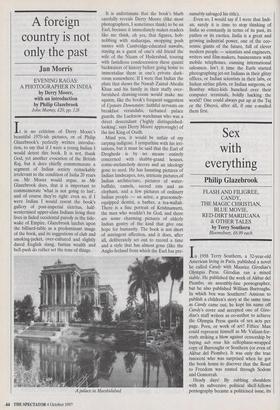A foreign country is not only the past
Jan Morris
EVENING RAGAS: A PHOTOGRAPHER IN INDIA by Derry Moore, with an introduction by Philip Glazebrook John Murray, £20, pp. 128 It is no criticism of Deny Moore's beautiful 1970-ish pictures, or of Philip Glazebrook's perfectly written introduc- tion, to say that if I were a young Indian I would detest this book. It is not, thank God, yet another evocation of the British Raj, but it does chiefly commemorate a segment of Indian society remarkably irrelevant to the condition of India 20 years on. Mr Moore would argue, as Mr Glazebrook does, that it is important to commemorate 'what is not going to last', and of course they're right: even so, if I were Indian I would resent the book's gallery of post-imperial detritus, half- westernised upper-class Indians living their lives in faded occidental parody in the tide- wake of Empire. Glazebrook latches upon the billiard-table as a predominant image of the book, and its suggestions of club and smoking-jacket, over-cultured and slightly dated English slang, fustian wealth and bell-push do rather set the tone of things. It is unfortunate that the book's blurb carefully reveals Deny Moore (like most photographers, I sometimes think) to be an Earl, because it immediately makes readers like me think, oh yes, that figures, hob- nobbing with maharajas, swopping posh names with Cambridge-educated nawabs, staying as a guest of one's old friend the wife of the Nizam of Hyderabad, touring with fastidious condescension these quaint backwaters of history before going home to immortalise them in one's private dark- room somewhere. If I were that Indian the plate that shows the Nawab Zainul Abedin Khan and his family in their stuffy over- furnished drawing-room would make me squirm, like the book's frequent suggestion of Upstairs Downstairs: faithful servants on breakfast verandahs, turbaned palace guards, the Lucknow watchman who was a direct descendant ('highly distinguished- looking', says Derry Moore approvingly) of the last King of Oudh.
Mind you, it would be unfair of my carping indigene. I sympathise with his irri- tations, but it must be said that the Earl of Drogheda is by no means entirely concerned with shabby-grand houses, comic-melancholy decors and an ideology gone to seed. He has haunting pictures of Indian landscapes, too, intricate pictures,of Indian architecture, pictures of water- buffalo, camels, sacred rats and an elephant, and a few pictures of ordinary Indian people — an actor, a gruesomely- equipped dentist, a barber, a tea-wallah. There is a fine portrait of Krishnamurti, the man who wouldn't be God, and there are some charming pictures of elderly Indian gentry of the kind that give one hope for humanity. The book is not short of astringent affection, and it does, after all, deliberately set out to record a time and a style that has almost gone (like the Anglo-Ireland from which the Earl has pre- A palace in Murshidabad sumably salvaged his title).
Even so, I would say if I were that Indi- an, surely it is time to stop thinking of India so constantly in terms of its past, its pathos or its exotica. India is a great and growing industrial power, one of the eco- nomic giants of the future, full of clever modern people — scientists and engineers, writers and film-makers, businessmen with mobile telephones, cunning international salesmen. Isn't it time the Earls started photographing jet-set Indians in their glitzy offices, or Indian scientists in their labs, or Indian airline pilots, or Indian surgeons, or Bombay whizz-kids hunched over their computer terminals, boldly hacking the world? One could always put up at the Taj or the Oberoi, after all, if one e-mailed them first.










































































 Previous page
Previous page